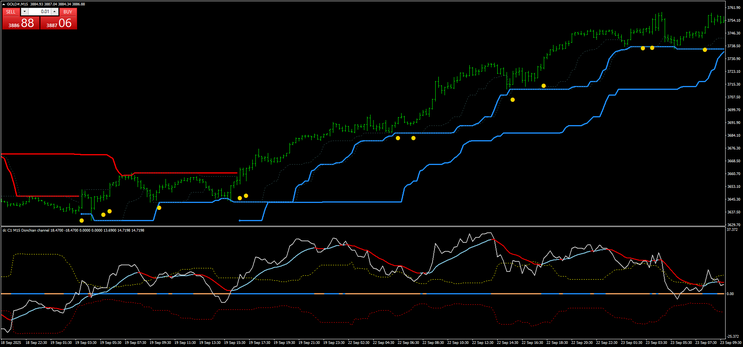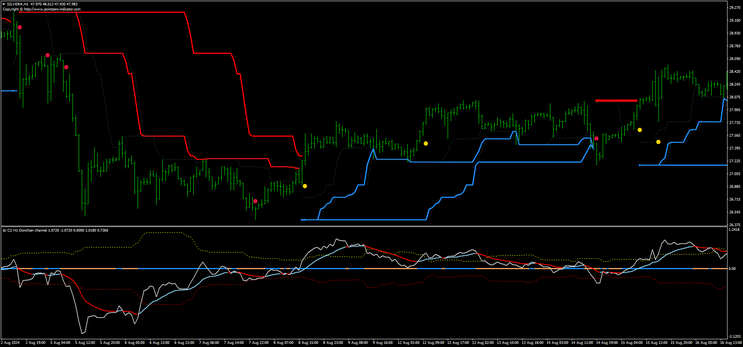244# Donchian Channel Strategy -Richiard Dennis Interpretation-
Janus Trader 2025
Donchian Channel: Richard Dennis Interpretation
The Donchian Channel is one of the most classic and effective trend-following tools used in technical trading. It was first developed by Richard Donchian and later became the cornerstone of Richard Dennis’s famous Turtle Trading System. This interpretation for MT4 combines multiple Donchian Channels to identify trend direction, entry timing, and confirmation through an oscillator.
Setup Overview (MT4 Template)
In this setup, three Donchian-based indicators are used:
-
Main Chart:
-
Donchian Channel 1 (20 – 10): Short-term channel for entry timing.
Donchian Channel 2 (55 – 21): Long-term channel to define the dominant trend.
Subwindow:
-
Donchian Oscillator (20:10): Acts as a momentum confirmation tool, plotting yellow dots on the main chart when entry conditions align.
-
This combination mirrors the dual-channel system that Richard Dennis used with his Turtles — a longer Donchian to identify trend direction and a shorter Donchian for entry timing.
Trading Philosophy
Richard Dennis believed that price is the ultimate indicator of market direction. His Turtle strategy followed breakouts from Donchian Channels — buying when price broke above a recent high and selling when it broke below a recent low. The goal was to catch large trends and let profits run while cutting losses quickly.
Trading Rules (MT4 Donchian Channel System)
1. Identify the Trend (using Donchian 55 – 21)
-
Uptrend: Price is above the midline of the 55-period Donchian Channel, and the upper band is rising.
Downtrend: Price is below the midline, and the lower band is falling.
This longer channel defines the market bias — trade only in the direction of this trend.
2. Entry Timing (using Donchian 20 – 10 and Oscillator 20:10)
-
Buy Setup:
-
Price breaks above the upper band of the 20-period Donchian Channel.
The Oscillator 20:10 confirms upward momentum (white line above red line).
A yellow dot appears on the chart — signaling an optimal entry aligned with both trend and momentum.
Sell Setup:
-
Price breaks below the lower band of the 20-period Donchian Channel.
The Oscillator 20:10 confirms downward momentum.
A yellow dot marks the signal candle.
-
3. Stop-Loss and Exit
-
Initial Stop-Loss: Place below the opposite Donchian band of the short-term channel.
Trailing Stop: Use the opposite side of the 20-period Donchian Channel to trail the trade.
Exit: When price closes beyond the opposite band or when a yellow dot in the opposite direction appears.
4. Position Sizing
-
Richard Dennis taught to risk a fixed percentage per trade (typically 1–2% of equity) based on the volatility of the Donchian range.
In the chart example:
-
The blue Donchian (55 – 21) highlights the dominant uptrend phases.
The red Donchian (20 – 10) provides tactical entry signals within that broader trend.
Yellow dots confirm synchronized signals between price breakouts and oscillator momentum.
When both channels align and the oscillator confirms, the probability of trend continuation is significantly higher — this is the essence of the Turtle approach.
-
It is important to note that adding to positions should only be considered when the daily timeframe confirms a strong, sustained trend in the same direction.
In other words, multi-entry setups like the one shown here work best when:
-
The daily Donchian Channel is clearly trending downward,
-
Price consistently trades below the midline or lower band of the daily channel, and
-
Momentum indicators (such as the Donchian oscillator in the subwindow) confirm persistent bearish strength.
When these higher-timeframe conditions align, each short-term retracement toward the upper Donchian boundary (as seen here) offers a valid opportunity to add positions with the trend — following Richard Dennis’s original Turtle principle:
“Add to winners only when the higher trend remains intact.”
This disciplined, trend-based approach allows traders to compound profits safely while avoiding over-exposure in non-trending markets.
Conclusion
The Donchian Channel Richard Dennis Interpretation for MT4 captures the
spirit of the original Turtle Trading System with modern visualization tools.
By combining two Donchian periods — one for trend and one for timing — along with an oscillator filter, traders can achieve clearer entries and exits in trending markets.
This setup encourages discipline, patience, and consistency — the same principles that allowed Richard Dennis’s Turtles to succeed decades ago.
The Original Richard Dennis Turtle Trading Rules
The Donchian Channel strategy described above draws its inspiration from one of the most iconic trend-following experiments in trading history —
Richard Dennis’s Turtle Trading System from the early 1980s.
Richard Dennis, together with his partner William Eckhardt, set out to prove that successful trading could be taught systematically through a set of mechanical rules — not intuition or
luck.
1. The Core Philosophy
Dennis believed that price is truth — everything known about the market
is reflected in price.
Therefore, the best way to profit is to follow price breakouts and let the market itself determine the
trend.
His traders, known as the Turtles, were taught to act mechanically and avoid any emotional bias.
2. The Original System Structure
The Turtles used two Donchian-style breakout systems:
-
System 1:
Entry on a 20-day breakout (price breaks above the highest high or below the lowest low of the past 20 days).
Exit on a 10-day opposite breakout (for example, close a long when price breaks below the 10-day low).System 2:
Entry on a 55-day breakout, with a 20-day opposite breakout for exits.
This longer-term system was designed to capture major market trends.
These two systems mirror your MT4 configuration — where the longer Donchian (55–21) identifies the global trend, and the shorter Donchian (20–10) gives tactical entry signals.
3. Risk Management & Position Sizing
Dennis taught that risk control is everything.
Each trade risked only a small, fixed percentage of total equity (typically 1–2%), with position size adjusted to market volatility using the Average
True Range (ATR).
Key concepts:
-
Uniform risk: every position, regardless of market, carries the same risk weight.
-
Add to winners: traders could pyramid into profitable positions by adding units as the trend strengthened.
-
Cut losses quickly: stop-losses were non-negotiable and placed immediately after entry.
4. Market Scope & Diversification
The Turtles traded a wide range of liquid futures markets —
commodities, currencies, interest rates, and stock indices — to ensure that when one market was consolidating, another might be trending.
The system relied on the law of large numbers: a few big trends would offset many small losses.
5. Discipline and Psychological Strength
Perhaps the most vital rule was discipline.
Traders were forbidden from overriding the system, skipping signals, or hesitating to act.
Consistency — not prediction — was the key to long-term success.
Richard Dennis summarized it best:
“You could publish my trading rules in the newspaper, and no one would follow them. The key is consistency and discipline.”
6. Modern Interpretation
Your MT4 Donchian setup is a modernized, visual interpretation of this
legendary approach.
By combining:
-
A long-term Donchian (55–21) for trend definition,
A short-term Donchian (20–10) for entry timing, and
A Donchian Oscillator (20:10) for momentum confirmation,
Conclusion
The Richard Dennis Turtle Rules remain one of the purest expressions of
systematic trend following.
Integrating these timeless ideas into your Donchian Channel MT4 strategy offers not only a practical trading framework but also a deep cultural connection to one of the most successful
experiments in trading history.
Tom DeMark Trading Strategies
Tom Demark Price Projection
Submit by joy22
In this page there are a list of studies on Tom Demark supplemented
by indicators of the trendline of Tom DeMark. The list is:
Tom DeMarkTDLT,
Tom Demark Price Pojection 01,
Tom Demark Price Pojection 02,
Tom Demark Price Pojection 03,
Tom Demark TrendLine,
Tom Demark Trendlines-fb1,
Demark_trend_new,
Ind_TD_DeMark_3_1_,
Ind-TD-DeMark-3,
In the pictures below Tom Demark price projectionin action.

Tom Demark TDLT
Tom Demark Price Pojection 01
Tom DeMark Trading Method
104# Tom De Mark Trend line Strategy - Forex Strategies - Forex ...
244# Tom DeMark Trading Strategies - Forex Strategies - Forex ...
2# Tom Demark FX system - Forex Strategies - Forex Resources ...
14# DeMarK System - Forex Strategies - Forex Resources - Forex
DeMark Metatrader Indicator - Forex Strategies - Forex Resources ...
408# Thomas DeMark's Sequential (tm) System - Forex Strategies ...













